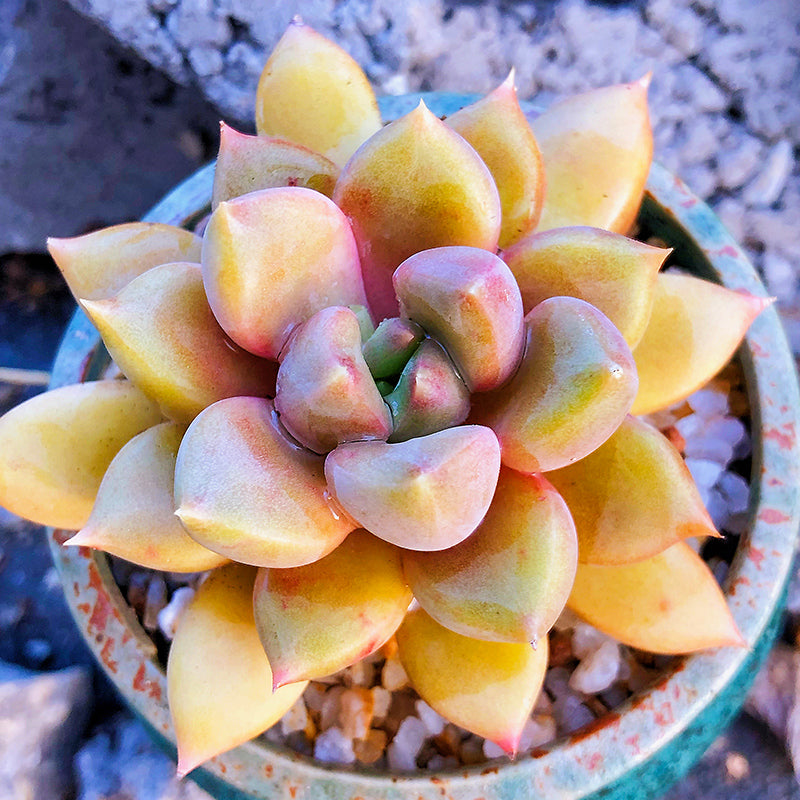Echeveria J.C. Van Keppel, a small-sized variety, with single heads measuring 3-4cm. Its leaves are short, spoon-shaped, sharply pointed, and densely arranged. The leaf surface is smooth and waxy, and the plant usually maintains a light green color throughout the year. Under sufficient sunlight and significant temperature fluctuations, the leaves may show slight orange-yellow hues, and when in optimal condition, they may even exhibit a jelly-like appearance, with red tips.
Growth habits and care methods for Echeveria J.C. Van Keppel:
Echeveria J.C. Van Keppel is not difficult to care for and is prone to clustering. It grows during the spring, autumn, and winter seasons, requiring ample sunlight during growth periods to facilitate coloration. However, it is susceptible to sunburn (often leading to sunspots), so shading during the summer and reducing watering frequency are advisable.
Regarding soil selection, loose, well-draining soil is preferred, and specific choices can vary based on personal preference.
Propagation method for Echeveria J.C. Van Keppel:
Echeveria J.C. Van Keppel tends to cluster but grows slowly. Branch cuttings are generally preferred for propagation, although leaf cuttings are also viable. When taking leaf cuttings, it is advisable to remove them from the base and allow the wounds to dry before planting in coarse sand or vermiculite. Keep the pot in a well-ventilated, partially shaded area and ensure the soil remains slightly moist. Roots should develop within 3-4 weeks.
Growing environment:
Echeveria J.C. Van Keppel prefers a warm, dry, and sunny environment, tolerating drought and slight cold. It can also tolerate partial shade. During the hot summer months, the plant may enter a brief dormant period, characterized by slow or complete cessation of growth. In such cases, proper ventilation and some shading are recommended to prevent prolonged exposure to rain and excessive watering. The primary growth periods are spring, autumn, and early summer. Water the soil thoroughly during the growth period, but avoid excessive dryness, which can cause older leaves to wither (except during dormancy). In winter, if the temperature remains above -2°C, continue watering as usual to sustain growth. However, if lower temperatures cannot be maintained, gradually reduce watering to induce dormancy. The plant can tolerate temperatures as low as -6°C when the soil is dry.
Sunlight:
Maintain adequate sunlight during the care process, but avoid prolonged exposure to high temperatures. Like other succulents, Echeveria J.C. Van Keppel should be placed in a location with ample sunlight for healthy growth. However, it is not tolerant of excessive heat and sun exposure. During hot summer temperatures, even a slight oversight can cause leaf burn or water loss. Therefore, pay close attention to weather changes and provide shade as necessary.
Watering:
Water only when the soil has dried completely. Echeveria J.C. Van Keppel is particularly drought-tolerant, so watering should be strictly controlled. Wait until the soil is completely dry before watering to prevent thinning and weakening of the leaves and potential root problems.
Soil mix:
The soil mix should be well-draining, as Echeveria J.C. Van Keppel adapts well to different soil conditions and is less prone to disease. A mixture of coal slag and peat moss, with an emphasis on aeration, is suitable. There is no specific ratio required. Cover the surface of the pot with granular river sand for both aesthetics and improved aeration.
Fertilization:
During the growing season, apply a small amount of succulent fertilizer to meet the plant's nutritional needs and promote faster growth. However, avoid excessive or frequent fertilization, as it can lead to fertilizer damage.
